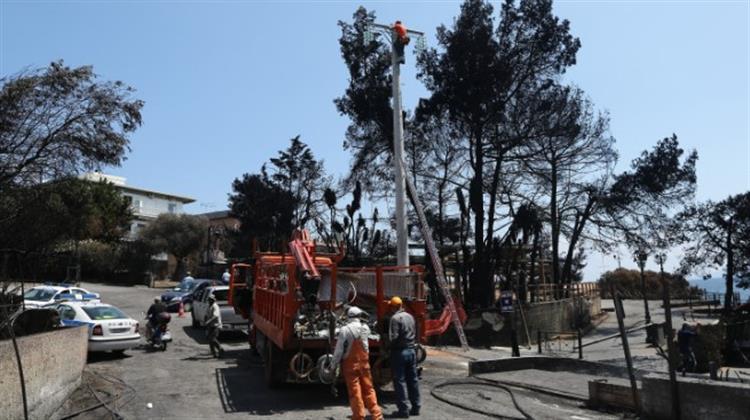The raging fires, which have engulfed most of Greece for almost two weeks, apart from the unprecedented ecological devastation and huge loss of property, challenged the stability of the country’s electricity system.
As some analysts familiar with Greece’s electricity market argue, the problem is not so much related to the adequacy of installed capacity; it narrows down to the failings of the distribution and transmission system.
With more than 20 GW of installed capacity and good cross-border interconnections with neighbouring countries, meeting electricity demand even when this peaked at 10,900 MWh on Tuesday (3/8) was not much of a problem.
Out of this capacity, only 9,000 to 9,500 MW is available at any one time since one-third of the installed capacity corresponds to variable renewables – mostly wind and solar – with the rest consisting of conventional thermal plants and large hydro dams.
The shortfall, as usual, was made up of electricity imports.
Given the severity of the situation in terms of high energy demand, with temperatures soaring above 40 degrees Celsius in most parts of the country, the Independent Power Transmission Operator (IPTO) that manages Greece’s high voltage transmission system expected demand peaks over 11,000 MW.
For this reason, IPTO asked the incumbent Public Power Corporation (PPC) to bring in some old lignite-fired plants put in reserve, in addition to the ones currently in use, despite the high operational costs involved on account of expensive CO2 emission charges that PPC has to pay.
Hence, some 1,900 MW of lignite capacity was booked into the system in addition to gas-fired plants throughout last week.
As part of its national decarbonisation plan, the Greek government decided in September 2019 to press ahead by 2028 with an early shut down of PPC’s stable of lignite power plants with 4.0 GW installed capacity.
With some 1.6 GW of lignite plants already retired, the rest provided much-needed baseload to the electricity system throughout last week and proved their usefulness once again.
However, the real test of the national electricity system came from the extensive fire zones that spread simultaneously in several parts of the country.
According to government data, from August 1 to 8, some 586 fires erupted, while during the critical three-day period August 5-7, there were 90 active fire fronts at the same time.
Landlines taken off-grid
With most of the fires spreading over thousands of hectares, electricity transmission land lines faced intense heat. As a result, the transmission operator had to take many of them off the grid to avoid short-circuiting and thus a nationwide blackout.
So, the real problem arose not due to lack of available electricity capacity but due to limitations in the use of medium (20 kV) and high-voltage (150/400 kV) distribution and transmission lines.
As demand rose, the low- and medium-voltage electricity grid was overburdened, while electricity pylons came crashing to the ground and high-voltage transmission lines had to be idled to avoid melting down as they were at the epicentre of fierce fires.
The problem arose when parts of the grid had to be taken periodically off the grid resulting in rotating small-scale local blackouts over a 48 hour period (5/6 August).
Thanks to the skilful handling of the situation by the grid operators, a nationwide blackout was avoided, but at the expense of electrical current stability and the voluntary shut down by industry and businesses.
Given the country’s mountainous terrain intermingled with plains and valleys, with narrow gorges and hundreds of inhabited islands, a really extensive and difficult to manage electricity grid has emerged over the years.
This includes 112,622 km of medium voltage cables and 127,000 km of low voltage ones, mostly at 20 kV and 11,000 km of high voltage lines at 150/400 kV.
Complex network
A number of islands are interconnected to the national grid, in addition to 600 km of high voltage underwater electricity cables and 195 km buried underground.
Hence, Greece’s electricity grid has developed into a really extensive and complex network whose management, even in normal times, poses significant challenges.
The lethal combination of high temperatures, robust demand, and natural hazards, in the shape of raging fires, tested the country’s electricity network to its limit, and some useful lessons can be drawn.
For once, the vulnerability of distribution and transmission lines and electricity substations became obvious, and this is where a lot of thought and careful planning has to be expended, together with the undertaking of new works and careful execution to ring-fence the grid from similar future threats.
Although Greece’s extensive electricity grid and management centres have been developed and built using high European standards, it still lacks full automation in certain key control points, according to engineers familiar with the system.
Industry sources add that the further upgrading of certain weak parts of the electricity grid is now necessary.
However, this is a massive project and will need a multi-billion cash investment programme over the next two to three years to ensure that the grid will continue to function uninterrupted, providing stable and good quality electricity despite physical hazards.
With Greece gradually emerging as a major tourist and business destination hub in the southern tip of Europe and the increased reliance on electrically driven devices and infrastructure, the provision of uninterrupted and high-grade electricity is a sine qua non.
Costis Stambolis is a Financial Mirror correspondent based in Athens







